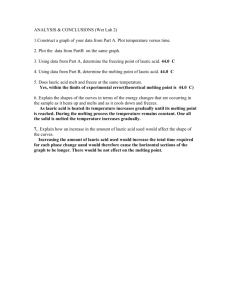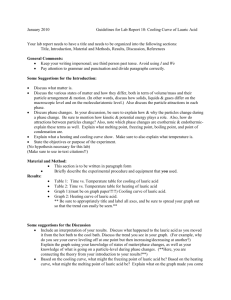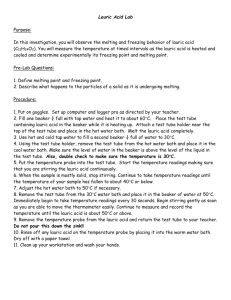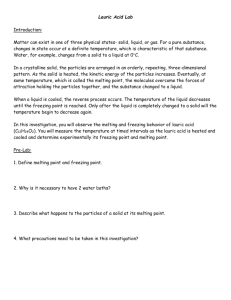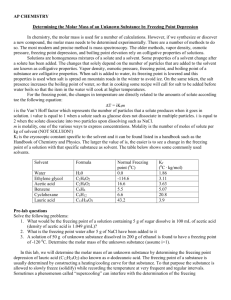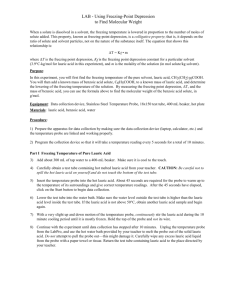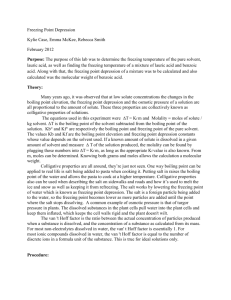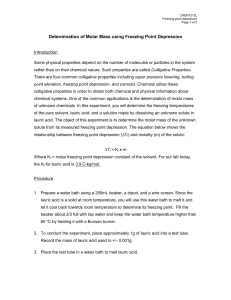Using Freezing-Point Depression to Find Molecular Weight
advertisement
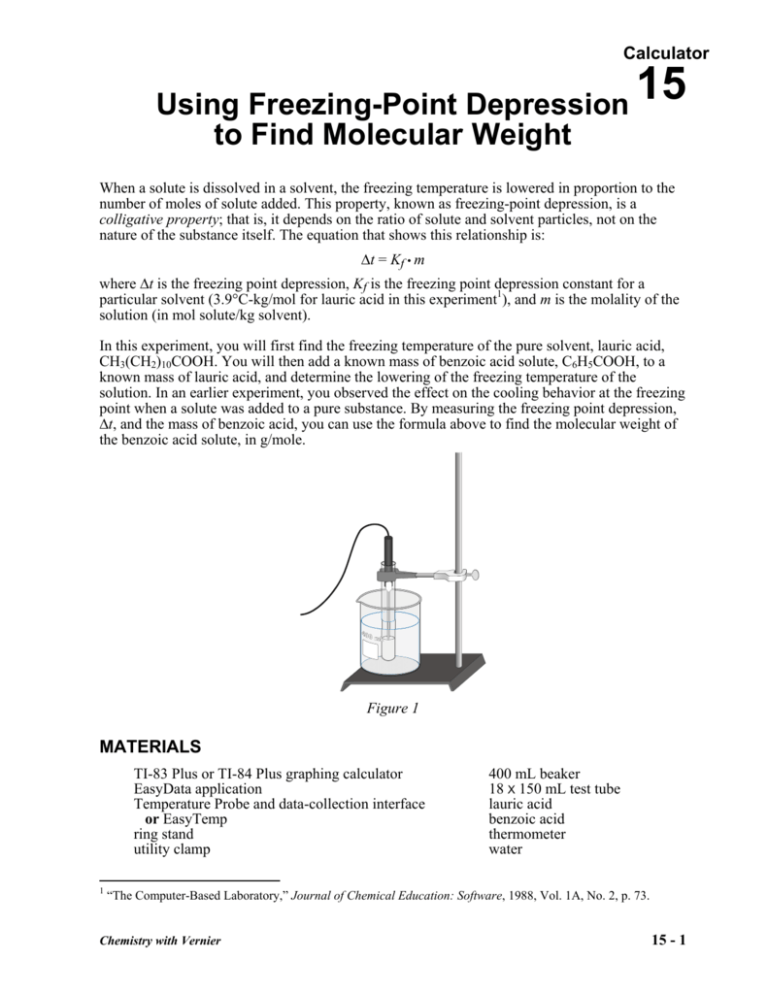
Calculator Using Freezing-Point Depression to Find Molecular Weight 15 When a solute is dissolved in a solvent, the freezing temperature is lowered in proportion to the number of moles of solute added. This property, known as freezing-point depression, is a colligative property; that is, it depends on the ratio of solute and solvent particles, not on the nature of the substance itself. The equation that shows this relationship is: ∆t = Kf • m where ∆t is the freezing point depression, Kf is the freezing point depression constant for a particular solvent (3.9°C-kg/mol for lauric acid in this experiment1), and m is the molality of the solution (in mol solute/kg solvent). In this experiment, you will first find the freezing temperature of the pure solvent, lauric acid, CH3(CH2)10COOH. You will then add a known mass of benzoic acid solute, C6H5COOH, to a known mass of lauric acid, and determine the lowering of the freezing temperature of the solution. In an earlier experiment, you observed the effect on the cooling behavior at the freezing point when a solute was added to a pure substance. By measuring the freezing point depression, ∆t, and the mass of benzoic acid, you can use the formula above to find the molecular weight of the benzoic acid solute, in g/mole. Figure 1 MATERIALS TI-83 Plus or TI-84 Plus graphing calculator EasyData application Temperature Probe and data-collection interface or EasyTemp ring stand utility clamp 1 400 mL beaker 18 X 150 mL test tube lauric acid benzoic acid thermometer water “The Computer-Based Laboratory,” Journal of Chemical Education: Software, 1988, Vol. 1A, No. 2, p. 73. Chemistry with Vernier 15 - 1 Calculator 15 PROCEDURE 1. Obtain and wear goggles. 2. Turn on the calculator. Connect the Temperature Probe, data-collection interface, and calculator. (If you are using an EasyTemp, you do not need a data-collection interface.) 3. Set up EasyData for data collection. a. b. c. d. e. f. g. Start EasyData if it is not already running. Select from the Main screen, and then select New to reset the application. Select from the Main screen, then select Time Graph… Select on the Time Graph Settings screen. Enter 6 as the time between samples in seconds. Select . Enter 100 as the number of samples and select (data will be collected for 10 minutes). h. Select to return to the Main screen. Part I Freezing Temperature of Pure Lauric Acid 4. Add about 300 mL of tap water with a temperature between 20 and 25°C to a 400 mL beaker. Place the beaker on the base of the ring stand. 5. Use a utility clamp to obtain a test tube containing hot melted lauric acid from your teacher. Fasten the utility clamp at the top of the test tube. Caution: Be careful not to spill the hot lauric acid on yourself and do not touch the bottom of the test tube. 6. Insert the Temperature Probe into the hot lauric acid. About 30 seconds are required for the probe to warm up to the temperature of its surroundings and give correct temperature readings. During this time, fasten the utility clamp to the ring stand so the test tube is above the water bath. 7. After the 30 seconds have elapsed, select to begin data collection. 8. Lower the test tube into the water bath. Make sure the water level outside the test tube is higher than the lauric acid level inside the test tube. If the lauric acid is not above 50°C, obtain another lauric acid sample and begin again. 9. With a very slight up and down motion of the Temperature Probe, continuously stir the lauric acid during the cooling. Hold the top of the probe and not its wire. 10. Data collection will stop after 10 minutes. Use the hot water bath provided by your teacher to melt the probe out of the solid lauric acid. Do not attempt to pull the probe out—this might damage it. Carefully wipe any excess lauric acid liquid from the probe with a paper towel or tissue. Return the test tube containing lauric acid to the place directed by your teacher. 11. To determine the freezing temperature of pure lauric acid, you need to determine the temperature in the portion of the graph with nearly constant temperature. Examine the data points along this portion of the graph. As you move the cursor right or left, the time (X) and temperature (Y) values of each data point are displayed above the graph. Determine this temperature, either by visually approximating the value or by taking the mathematical average of the temperatures in this plateau. Record the freezing temperature of pure lauric acid in your data table (round to the nearest 0.1°C). 15 - 2 Chemistry with Vernier Using Freezing-Point Depression to Find Molecular Weight 12. To determine the freezing temperature of pure lauric acid, you need to analyze the portion of the graph with nearly constant temperature. To do this: a. Select , and then select Statistics… b. Use to move the cursor to the beginning of the flat section of the curve. Select to set the left boundary of the flat section. c. Move the cursor to the end of the flat section of the graph, and select to set the right boundary of the flat section. The program will now calculate and display the statistics for the data between the two boundaries. d. Record the mean value as the freezing temperature in your data table (round to the nearest 0.1°C). e. Select , then select to return to the Main screen. 13. Store the data from the first run so that it can be used later. To do this: a. From the Main screen, select , and then select Store Run. b. Select to store your latest data and overwrite the data in Lists 3 and 4 (L3 and L4). Part II Freezing Temperature of a Solution of Benzoic Acid and Lauric Acid 14. Select , then to begin data collection. Your stored data will not be overwritten. 15. Obtain a test tube containing a melted solution with ~1 g of benzoic acid dissolved in ~8 g of lauric acid. Record the precise masses of benzoic acid and lauric acid as indicated on the label of the test tube. Repeat Steps 4–10 to determine the freezing point of this mixture. 16. To determine the freezing point of the benzoic acid-lauric acid solution, you need to determine the temperature at which the mixture first started to freeze. Unlike pure lauric acid, cooling a mixture of benzoic acid and lauric acid results in a slow gradual drop in temperature during the time period when freezing takes place. Examine the data points to locate the freezing point of the solution, as shown in this figure. As you move the cursor right or left on the displayed graph, the time (X) and temperature (Y) values of each data point are displayed above the graph. Record the freezing point (round to 0.1°C). Freezing Point Time 17. A good way to compare the freezing curves of the pure substance and the mixture is to view both sets of data on one graph. To do this: and then select L2 and L3 vs L1. a. Select b. Both temperature runs should now be displayed on the same graph. Each point of Part I (pure lauric acid) is plotted with a square, and each point of Part II (benzoic acid and lauric acid) is plotted without a marker. 18. Print a graph of temperature vs. time (with two curves displayed). Label each curve as pure lauric acid or benzoic acid and lauric acid. PROCESSING THE DATA 1. Determine the difference in freezing temperatures, ∆t, between the pure lauric acid (t1) and the mixture of lauric acid and benzoic acid (t2). Use the formula, ∆t = t1 - t2. Chemistry with Vernier 15 - 3 Calculator 15 2. Calculate molality (m), in mol/kg, using the formula, ∆t = Kf • m (Kf = 3.9°C-kg/mol for lauric acid). 3. Calculate moles of benzoic acid solute, using the answer in Step 2 (in mol/kg) and the mass (in kg) of lauric acid solvent. 4. Calculate the experimental molecular weight of benzoic acid, in g/mol. Use the original mass of benzoic acid from the Data and Calculations table, and the moles of benzoic acid you found in the previous step. 5. Determine the accepted molecular weight for benzoic acid from its formula, C6H5COOH. 6. Calculate the percent error. DATA AND CALCULATIONS Mass of lauric acid g Mass of benzoic acid g Freezing temperature of pure lauric acid °C Freezing point of the benzoic acid–lauric acid mixture °C Freezing temperature depression, ∆t °C Molality, m mol/kg Moles of benzoic acid mol Molecular weight of benzoic acid (experimental) g/mol Molecular weight of benzoic acid (accepted) g/mol Percent error % 15 - 4 Chemistry with Vernier
